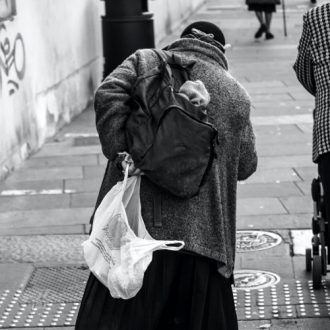“Ben really isn’t keeping up well. He looks fine, but he’s been complaining and he’s constantly out. […] You don’t see a change with everyone, but with him […] it’s so obvious. He is back on the crack, too. And he was supposed to move out soon – but at the moment nobody is moving, really. They are all staying longer than the 28 days [the supposed length of an average stay at the homeless hostel].”
I am standing behind the counter in the kitchen with my co-volunteer Dannie on a Wednesday evening in early April as we are watching Ben enter the extensive ‘lounge’ area in the Hostel. He nervously walked in zig-zag through the room towards us, watching his every step. Grabbing a bag of chips out of one of the big, donated cartons, he comes to a stand in front of us. The dinner behind us is bubbling away; everything is ready and the first group of people is already sitting on the tables spread out across the room. There isn’t exactly enough space to keep social distance over dinner, but people are being reasonably careful. A handful of the residents are lounging on the big couches, one couch per person; most of the faces turned towards the TV. As often in recent months, as Dannie also explained to me, some action movie was on. “They like all these movies in which gangsters win against the police. I don’t know what it is at the moment. Lots of violence.”
I smile at Ben whom I had not met before: “Do you also want dinner? Any special requests?”
His face looked swollen and his teeth were grinding. He couldn’t stand still and barely looked me in the eye mumbling a short “No.” He fumbles with his pants as I prepare his plate, and I observe him sitting down alone and within minutes disappear downstairs.
***
In a recent Harvard Health post, a US-frontline doctor (and recovered opiate user) reports on the intersection of what he calls the ‘two great epidemics of our generation’. Not only does he argue that people suffering from addiction ‘are vastly more vulnerable to coronavirus’, they also suffer additionally from shortages of supplies (of methadone and other medications, for instance, at times even clean needles) and of increased issues of isolation, specifically when it comes to the lack of access to their recovery community and peer-support groups.
Accessing services such as drug testing and mental health support was temporarily impossible indeed.
In the context I observed in the UK, not only was accessing supply but also specialised services complicated when the ‘stay-at-home’ orders were introduced in March. Accessing services such as drug testing and mental health support was temporarily impossible indeed. Many addiction, mental health and move-on services were inaccessible for the first phase of lockdown in late March and early April. The focus was on protecting staff and putting rules and guidelines in place first. In effect, this made it even more important to provide the appropriate kind of support, particularly for people with complex needs, such as addiction, in the institutions where they were finding shelter.
How did health institutions deal with the additional pressure, particularly given the absence of specific government guidance? What kind of problems became particularly pressing? Which rules changed and how did responsibilities shift? This takes us back to Ben disappearing downstairs.
***
In my ongoing conversations with one of the Hostel managers, John, I learnt how over time, many rules were adapted; some guidelines had to be turned upside down more or less immediately, others shifted more slowly over the weeks after the virus started spreading and people were locked down completely. Many of the changes marked attempts to balance accommodating residents’ (individual) needs and the overall responsibility of staff and management for the health of all residents.
Four weeks into the lockdown, there were no restrictions anymore on which alcoholic drinks were allowed.
One of the almost immediate adaptations of rules concerned the consumption of alcohol. Downstairs – Ben’s refuge straight after dinner – was where alcohol was now allowed in the Hostel. First, it was only for beverages with up to 5% alcohol; that rule was quickly relaxed further to anything but glass bottles. Four weeks into the lockdown, there were no restrictions anymore on which alcoholic drinks were allowed. However, consumption was still only permitted in a specific section downstairs; people’s bedrooms remained taboo. Before Covid-19, the Hostel was ‘dry’, with a strict no-alcohol-inside policy. “But how are we supposed to keep that up when people aren’t allowed to leave? They aren’t even allowed to sit in the park. […] Many of our residents have an addiction problem. […] That’s the least I can do. We even buy it for people if they are self-isolating and ask us to. […] One of our biggest problem is keeping people inside, behavioral issues, really.” John was considerate from the beginning, thoughtfully reflecting about rules, action and their effects. But alcohol was indeed only the starting point, one of the substances that people were consuming, but not the one with the strongest attraction and biggest complications.
Another one of the hostel staff, Ollie, made this point even more poignantly in a conversation with me early on during the first weeks of ‘stay-at-home’ orders: “I know from personal experience, if you are in a [heroin] withdrawal, nothing will stop you going out to get your substance; coronavirus won’t even cross your mind.” Already before Covid-19, most people working (and volunteering) in the Hostel knew that many of its coming-and-going inhabitants had substance-use issues; mostly, it was heroin and crack that people consumed, on top of alcohol and Marijuana. But while considering the complications that came with addiction during lockdown, Ollie was also concerned about giving up on rules too quickly and too extensively: “If you turn a blind eye to it: drug-dealing, drug-sharing, violence, reliance on each other – it’s a whole different culture!” Ollie was weary of relaxing all the rules as he expected the situation to slide out of control, leading to a broad shift of modes of interaction that would not be beneficial for the overall situation at the Hostel.
What was the best practice to both support people in managing their addiction and to keep the Hostel as a whole secure?
John was possibly even slightly more open to experimentation than Ollie, particularly regarding the short-term goal of protecting the whole community from the quickly spreading virus. The most important immediate goal for him as the manager was to enable every resident (and member of staff) to follow the government guidance of staying in as much as possible.
What was the best practice to both support people in managing their addiction and to keep the Hostel as a whole secure? In a slightly longer-term view, it wasn’t clear how far one could and should go when relaxing rules; how easily would you be able go back ‘to normal’, to stricter rules, once the lockdown was rolled back? John was open to seeing this phase of changing rules as a trial period: “Once this whole coronavirus has died down, it will give us a possibility to re-evaluate what worked well, what didn’t work well.”
***
While in the beginning, everyone was experimenting – there was no playbook, no government-issued guidance – more recently, after several weeks of ‘stay-at-home’ orders, things started to calm down. When rules were tried out and not necessarily fully enforced originally (people like Ben leaving often and for long stretches of time for instance), recent weeks saw a re-enactment of a more solid structure. On the one hand, the very regular meetings between key workers and residents resumed; these meetings are in many ways the most important support for many people, including with solving problems like linking people up to adequate care for their addiction. On the other hand, rules, particularly about staying inside, were more strictly enforced. Several people were evicted for repeated transgressions of rules; residents were warned twice when breaking rules and made aware of the eventual consequences but eventual several people were asked to leave when a third breach occurred. The atmosphere was in fact calmer as a result; there was an understanding that while individual needs were met as much as possible – by providing methadone scripts, for instance and resuming on-site drug testing –, the overall goal was keeping the shelter and all inhabitants (and staff) safe. Surely also as a result of this strategy, there still had not been a case of Covid-19 inside; none of the residents had even been self-isolating for weeks.
Some people were left out of this focus, they fell through the cracks of the service institution.
Was there a flipside to this strategy, however? You could perhaps describe it as focused on the majority, on the ‘average homeless person’. The goal – as with the much broader public health-strategy implied by containment and ‘stay-at-home’ orders – was to keep as many people as possible safe. Some people were left out of this focus, they fell through the cracks of the service institution.

What if you weren’t able to keep your consumption of – say – heroin as low as twice a day – the number of times you were allowed to leave the Hostel, for instance? What if you had special support needs when it came to your mental health? What if because these needs were unmet you were not able to follow the guidance as easily?
The focus on keeping the Hostel safe – the reasonable thing to do from a health and institutional perspective – leads a group of people to be exposed at least during the first weeks of confusion and uncertainty. In this sense, Covid-19 and the rules that swept across the world with it can be seen as a stress test. For the most part, the homeless institutions I observed scored very well. But certain people, often the most vulnerable when it came to substance use, were the hardest hit. Going forward, can we design an institutional infrastructure for homeless people that would be prepared to protect particularly these people in terms of crisis?
Notes
The research for this piece has been conducted in the UK as a volunteer and interviewer in a set of different homeless institutions from March to June 2020. All individuals have been informed about my role as a researcher and all names of individuals and institutions have been changed to safeguard people’s anonymity. I choose ‘Hostel’ as a descriptor for the different institutions throughout.




